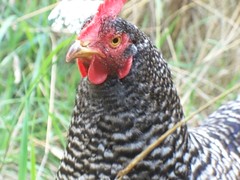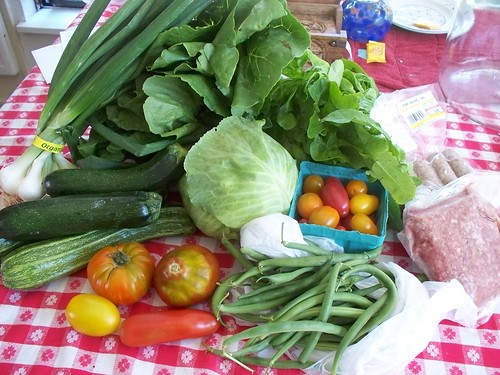 e Kitchen Kop) Real Food Wednesdays. I think this post is a little different than many of the others in this week's carnival, but it's something I've been meaning to write up for a while.
e Kitchen Kop) Real Food Wednesdays. I think this post is a little different than many of the others in this week's carnival, but it's something I've been meaning to write up for a while.Fats and Oils
 d fats and are regularly rancid by the time they get to your kitchen. Source and learn to use coconut oil, lard, bacon grease and ghee for your cooking.
d fats and are regularly rancid by the time they get to your kitchen. Source and learn to use coconut oil, lard, bacon grease and ghee for your cooking.Read labels of any store lard before buying it. Every one I’ve seen contains hydrogenated lard and preservatives that are not traditional in any way. Save fat from pork roasts and learn to render your own lard if you can’t find it from a farmer.
Healthy Meat and Bone Broth
Use your homemade stock to cook rice and beans. The gelatin and minerals make this cost effective vegetarian fare so much more nutritious. And it tastes delicious!
Eggs and Dairy
Buy the best quality eggs you can find. This is the first thing to find from a real farmer, you’ll never go back to store bought eggs again. Free range chickens that eat bugs and growing grass have vastly more vitamins and omega-3 fatty acids in their eggs. A good breakfast of eggs with bacon or sausage means that you and your loved ones will have the energy to get things done in the morning and not need to eat again until it truly is lunch time.
bugs and growing grass have vastly more vitamins and omega-3 fatty acids in their eggs. A good breakfast of eggs with bacon or sausage means that you and your loved ones will have the energy to get things done in the morning and not need to eat again until it truly is lunch time.
Learn about raw milk regulations in your state or region. It may be easier to get and/or cheaper than you may have thought.
Look for raw cheese and butter as well as grassfed cheese and butter in stores and online. Organic Pastures just came out with a pastured butter and Kerrygold Irish butter is always from grassfed cows. It's deep yellow color just screams about it's nutrition. Use regular store butter for cooking and as much eating as you can, but get these slightly more expensive products as real, nutritious treats.
Learn to make yogurt, villi, buttermilk or kefir. Culturing even storebought milk restores some of the nutrition that was lost through pasturization. You can use these cultured milk products in the Blender Batter recipes noted below!
Nutritious Plant Foods
Learn to make sauerkraut or other fermented vegetables. Sauerkraut is surprisingly easy to make, costs pennies per serving and goes miles towards improving digestion and overall health. Here are my easy directions for making sauerkraut, and a good article about why lacto-fermented vegetables are so darn healthy. P.S. I’m currently working my way through a quart of apple cranberry kraut made just like the instructions but with the addition of 2/3 of a tart apple, shredded and 1 cup cranberries, quartered, added to the cabbage before fermentation. Wow, so so good.
Master Sue Gregg’s blender batter pancake recipe. This recipe grinds whole grains in your blender with buttermilk, yogurt or kefir and soaks them over night to reduce phytic acid and make the grains more digestible. They can be made with any grain so are easily adapted to gluten free diets, can be made different flavors and can be made in big batches. Once cooked the pancakes or waffles can be frozen and reheated for a quick breakfast or lunch in the future.
Learn to shop seasonally for produce. Yes, this means eating kale and turnips and cabbage in the winter, but it also means eating tomatoes and peppers when they are cheap and taste good. Last  summer I bought bell peppers at the farmers market for 5 for 3 dollars and they were delicious! This winter my mom bought one green bell pepper for 99 cents, and it was not very flavorful. It’s too expensive, and it’s just not worth it.
summer I bought bell peppers at the farmers market for 5 for 3 dollars and they were delicious! This winter my mom bought one green bell pepper for 99 cents, and it was not very flavorful. It’s too expensive, and it’s just not worth it.
Winter vegetables lend themselves to roasting or creaming. Master the art of oven roasting root vegetables and you will never bemoan the lack of tomatoes in February ever again. Greens like kale, collards and mustard greens are so jam packed with nutrients it’s a crime they are so cheap. Learn to steam-sautee the greens with garlic and your family will thank you.
Learn to do some simple preserving like freezing or making berry jam to save some of the summer harvest. Frozen tomatoes cook up great, and you know exactly where they came from and just how cheap they were.
Sweets
Watch sugar content and make sure sweets have nutritive value. My general rule is that if a recipe for a non-dessert item has sugar in it, I simply leave it out or at the very least halve the amount. Small amounts of maple syrup or honey can be used, but they certainly aren’t necessary. When choosing sweet treats for your family choose ones that have real food products in them. Ice cream is much better nutrition-wise than white flour cookies, and fruit can be a great dessert. There are lots of recipes for desserts that include nuts, fruit, maple syrup, molasses, shredded vegetables, eggs, milk and other foods that provide actual nutrition, not just empty sugar and white flour calories.
least halve the amount. Small amounts of maple syrup or honey can be used, but they certainly aren’t necessary. When choosing sweet treats for your family choose ones that have real food products in them. Ice cream is much better nutrition-wise than white flour cookies, and fruit can be a great dessert. There are lots of recipes for desserts that include nuts, fruit, maple syrup, molasses, shredded vegetables, eggs, milk and other foods that provide actual nutrition, not just empty sugar and white flour calories.
Great to see you blogging about food! :)
ReplyDeleteAll your ideas are good ones to keep costs down. The only thing I can think of to add is to eat out less so you have more money to buy organic and local foods that are healthier anyway.
Oh, wait, here's another idea - eat your food before it goes bad, so it's not wasted. Also, save your left-overs for another day.
Now, if I can just convince my daughter to eat left-overs :)
Thanks for your post! These are all great ideas. I was amazed at the number of people who posted to the Carnival with tips instead of recipes. (I posted tips, myself.)
ReplyDeleteHey, great new blog! I'm going to bookmark it so I can point people here who are new to WAPF and need help getting going!
ReplyDelete